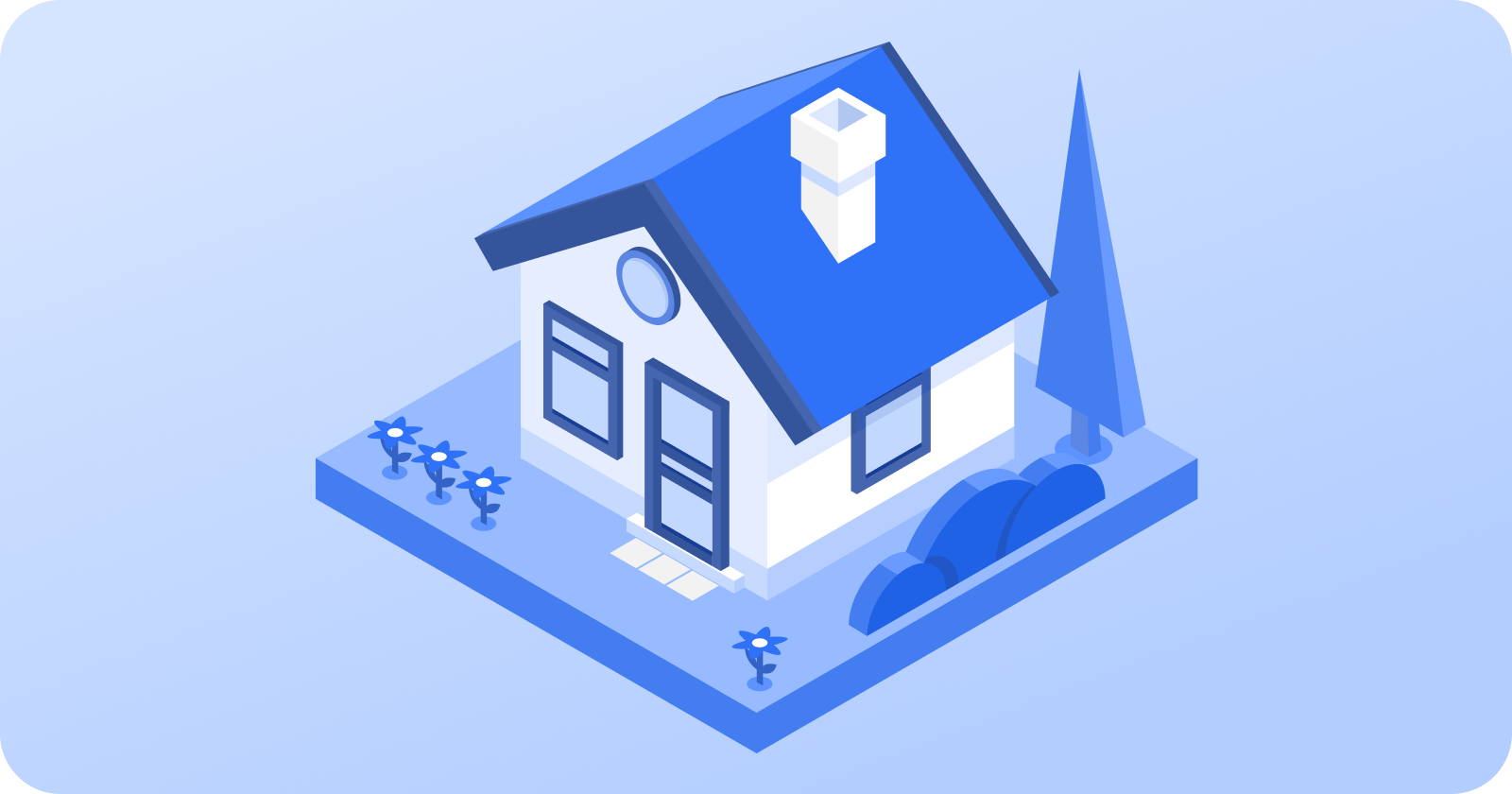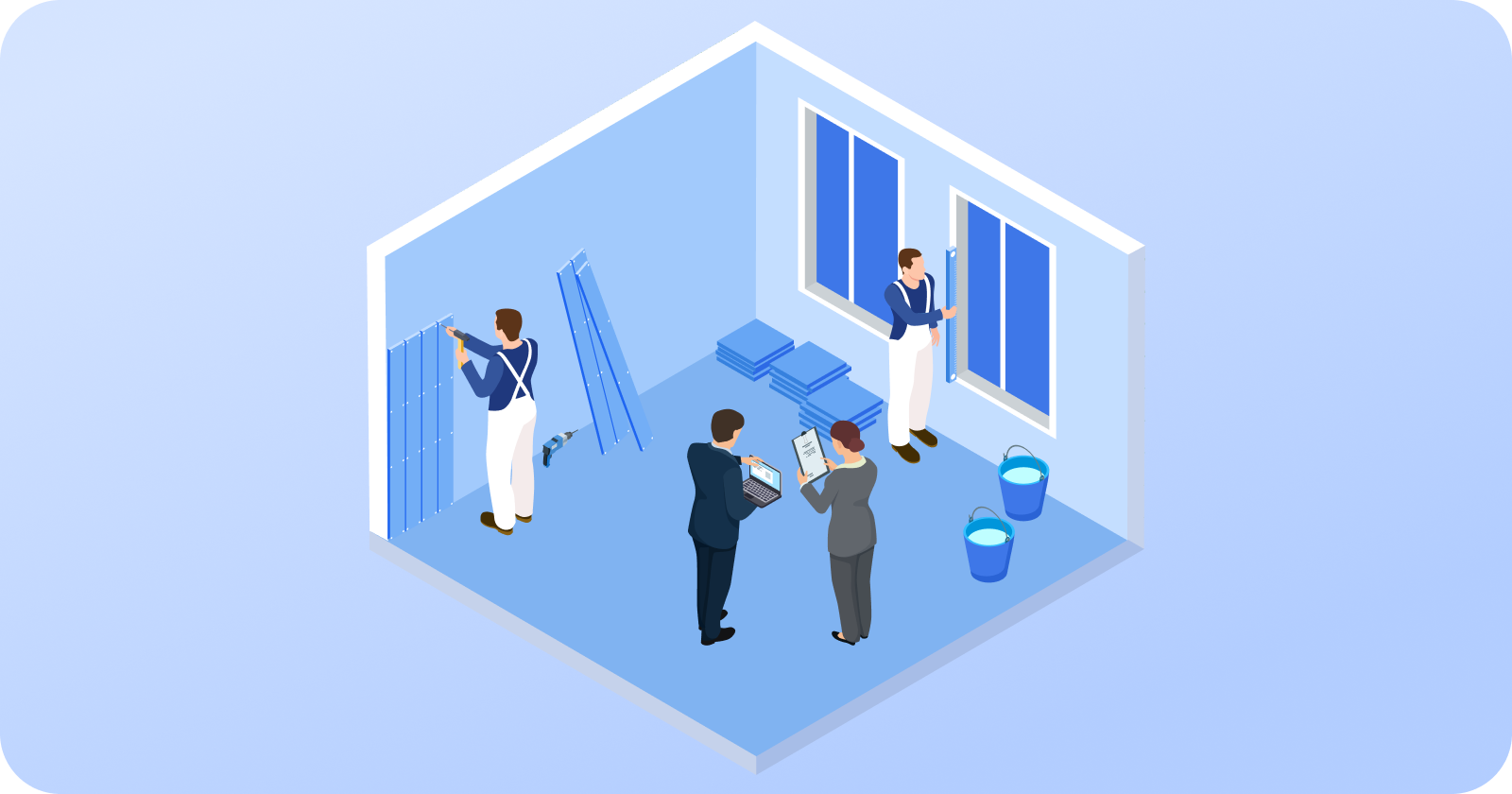From small duplexes to towering apartment high-rises, the multifamily property management involves combination of tenant needs, building maintenance, finances, and even renovations – all to keep properties profitable and residents happy.
In the U.S., rental housing is big business: about 45.6 million households are renters (roughly 35% of all households), and 39% of those renters live in apartment buildings. In fact, nearly one-third of all U.S. housing units are in multifamily properties.
This guide breaks down the essentials of multifamily property management – from what it entails and the types of properties involved, to the core responsibilities, common challenges, and the crucial role of renovations. Whether you’re a real estate investor, a property manager, or a landlord expanding into multifamily, consider this your 101 crash course in managing multi-unit properties.
What Does Multifamily Property Management Entail?
Multifamily property management means overseeing day-to-day operations of residential buildings with multiple units. Instead of a single-family home with one tenant, multifamily properties might have anywhere from two units in a duplex to hundreds of apartments in a high-rise. Managing these properties goes beyond collecting rent – it’s about creating a safe, well-maintained living environment and ensuring the investment remains profitable. Key aspects of multifamily management include:
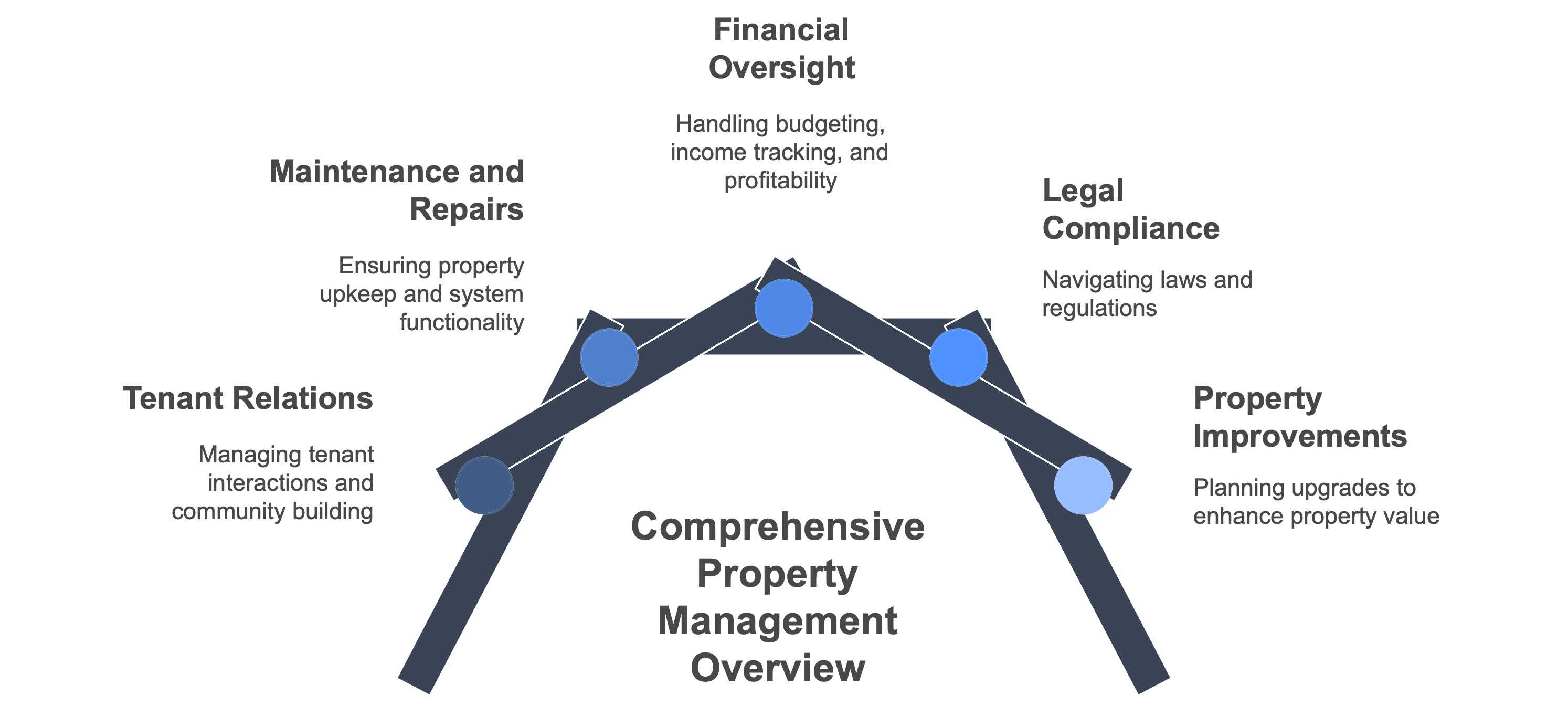
- Tenant relations. Handling lease signings, addressing tenant inquiries or complaints, and fostering a positive community atmosphere among neighbors.
- Maintenance and repairs. Keeping the property in good shape by fixing issues promptly and performing preventative maintenance on building systems (HVAC, plumbing, etc.).
- Financial oversight. Budgeting for expenses, tracking income, paying bills (utilities, taxes, insurance), and ensuring the property turns a profit for the owner.
- Legal compliance. Navigating landlord-tenant laws, safety codes, fair housing regulations, and all the paperwork that comes with them.
- Property improvements. Planning upgrades or multifamily property renovations to units and common areas to maintain competitiveness, increase property value, and meet modern standards.
In essence, a multifamily property manager wears many hats – administrator, handyman (or handiwoman), accountant, salesperson, and even project manager. The goal is to preserve or increase the property’s value while providing quality housing. It’s a dynamic role that can be both professionally rewarding and demanding, given the scale (multiple tenants and units) and complexity involved.
Did You Know? Nearly a quarter of U.S. rental buildings are over 50 years old. That means a huge portion of multifamily housing requires smart maintenance and renovation strategies to stay in shape.
From Duplexes to High-Rises: Types of Multifamily Properties
Not all multifamily buildings are the same. They come in a variety of sizes and styles, each with unique characteristics that can influence how they’re managed. Let’s explore the common types of multifamily properties – from a simple two-unit house to sprawling apartment communities:
Duplexes, Triplexes & Fourplexes (Small Multifamily)
These are 2-4 unit properties, often converted houses or purpose-built small apartments. A duplex is a single building split into two separate units (each with its own entrance); similarly, a triplex has three units, and a fourplex has four. Small multifamily homes often feel more like house living for tenants (more privacy and space) and might even be owner-occupied (e.g. an owner living in one unit and renting out the others).
Garden-Style Apartments
Think of a low-rise apartment community spread out over landscaped grounds. Garden apartments are typically clusters of 2-4 story buildings surrounded by lawns, gardens, or courtyards. They often appear in suburban areas where land is plentiful, providing a peaceful, community feel – perhaps with a pool or playground in the center. Each building might not have elevators, and units often open directly to the outside or via breezeways.
Mid-Rise Apartments
A step up in scale, mid-rise buildings are typically 5 to 8 stories tall and often found in urban or dense suburban locations. Mid-rises usually have elevators (once you exceed a few floors, it’s a necessity) and may include amenities like a lobby, gym, or community room. They strike a balance – taller than a garden apartment, but not a skyscraper. Management considerations include handling common areas (hallways, elevators) and possibly on-site staff like a concierge or maintenance technician for larger mid-rises.
High-Rise Apartments
These are the towers on the skyline – generally 10–12 floors or more (in many cities, “high-rise” means any residential building with a height requiring special fire-safety systems and elevators on every floor). High-rises can contain hundreds of units and residents, often with extensive amenities (doorman, parking garage, fitness centers, etc.). Managing a high-rise is a bit like running a small village: you may have full-time leasing staff, a maintenance crew, cleaning personnel, security, and more. There are complex building systems (boilers, HVAC, elevators, fire alarms) to maintain, and emergencies (like a water leak on the 20th floor) can affect many units at once.
Each type of multifamily property comes with its own management style. For instance, a duplex owner might handle everything personally and know their tenants by name, whereas a high-rise property manager might be part of a team with specialized roles (leasing agent, facility manager, etc.).
Regardless of type, all multifamily properties require attention to maintenance, tenant satisfaction, and financial performance. Understanding the property type helps set expectations – you wouldn’t manage a duplex the exact same way as a 200-unit apartment building, yet the core principles of good management apply to both.
Renovation needs also vary by property type. In a small fourplex, renovations might be done one unit at a time as tenants move out, with minimal disruption. In a large complex, managers might plan rolling renovations – upgrading a certain number of units each year – or coordinate big projects like replacing all the roofs or updating the parking lot.
The Multifamily Property Manager’s Role: Key Responsibilities
What does it actually mean to manage a multifamily property? Property managers are the unsung heroes (and sometimes jacks-of-all-trades) who keep investment properties running smoothly on behalf of the owners. In a multifamily context, this can be quite involved, because you’re dealing with multiple tenants and units simultaneously.
Here are the core roles and responsibilities of a multifamily property manager:
- Setting rents & collecting payments. Managers research local market trends to price units competitively and ensure steady cash flow. With U.S. apartment occupancy hovering around 95%, strategic pricing can maximize income. Rent collection also involves enforcing late fees and handling delinquencies professionally.
- Leasing & tenant relations. From advertising vacancies and screening tenants to signing leases and resolving complaints, managers handle it all. Good tenant relationships boost retention — important since each turnover can cost around $4,000. Satisfied tenants stay longer, keeping costs down.
- Maintenance & inspections. Property upkeep spans daily repairs to seasonal tasks like landscaping or HVAC servicing. Preventative maintenance helps avoid costly issues, especially in multifamily setups where one breakdown can affect several units. Managers also schedule regular inspections to spot problems early.
- Renovations & upgrades. Updating units and common areas is essential for staying competitive. Whether it’s a simple unit refresh or a full-scale lobby remodel, managers oversee timelines, budgets, and contractor coordination. Well-planned renovations can yield 20–30% ROI through increased rent and lower vacancy.
- Financial oversight. Managers create budgets, track income and expenses, and report financials to owners. Responsibilities may include paying bills, managing payroll (in larger buildings), and maintaining thorough records — all vital for compliance, tax reporting, and long-term planning.
- Compliance know-how. Property managers must follow local, state, and federal housing laws. That includes security deposits, lease notices, and safety standards. Staying compliant avoids legal trouble and keeps properties operating smoothly.
- Admin & communication. Acting as the go-between for tenants and owners, managers communicate updates, handle service requests, and document everything. Today, many use digital tools for rent collection, maintenance tracking, and even managing renovations.
Common Challenges in Multifamily Property Management (and How to Tackle Them)
Managing multifamily properties isn’t always smooth sailing – it comes with a set of common challenges that even experienced managers have to navigate.
High Turnover
About half of renters move out yearly, costing owners $3K–$4K per unit. Reduce churn by addressing maintenance issues quickly, offering lease renewal perks, and ensuring solid tenant screening.
Maintenance Overload
With aging buildings (23% are 50+ years old), repairs stack up fast. Prevent issues with scheduled maintenance, reliable contractors, and clear tenant repair request systems.
Tenant Conflicts
Noise, pets, or parking disputes can sour the community vibe. Set clear rules upfront, enforce them fairly, and mediate issues quickly. Hosting occasional events can also help build a friendlier environment.
Time Crunch
Juggling leasing, repairs, finances, and tenant concerns can be overwhelming. Lean on tools for automation, delegate where possible, and use SOPs and calendars to stay organized and prioritize wisely.
Economic Pressures
Rising costs and market competition tighten margins. Adjust rents based on local trends, control expenses smartly, and market your property’s strengths when facing new competition.
Renovation Headaches
75% of multifamily renos go over budget, and 77% run late. Avoid chaos by planning thoroughly, using platforms like RenoQuest to track progress and costs, and keeping tenants informed throughout the process.
How RenoQuest Makes Multifamily Renovations Easier
Renovations are essential for boosting rent, tenant satisfaction, and property value, but they’re also one of the hardest aspects to manage. That’s where RenoQuest comes in. Designed specifically for multifamily renovations, RenoQuest helps property managers streamline projects, save time, and stay on budget.
All-in-One Dashboard
![All-in-One Renovation Management [RenoQuest UX] All-in-One Renovation Management [RenoQuest UX]](https://renoquest.com/wp-content/uploads/2025/03/Group-270989688-e1743671192400.png)
RenoQuest replaces spreadsheets and scattered notes with a centralized platform. You can plan scopes of work, set budgets, and track unit-by-unit progress in real time, ideal for managing dozens of renovations across multiple properties.
Contractor Coordination
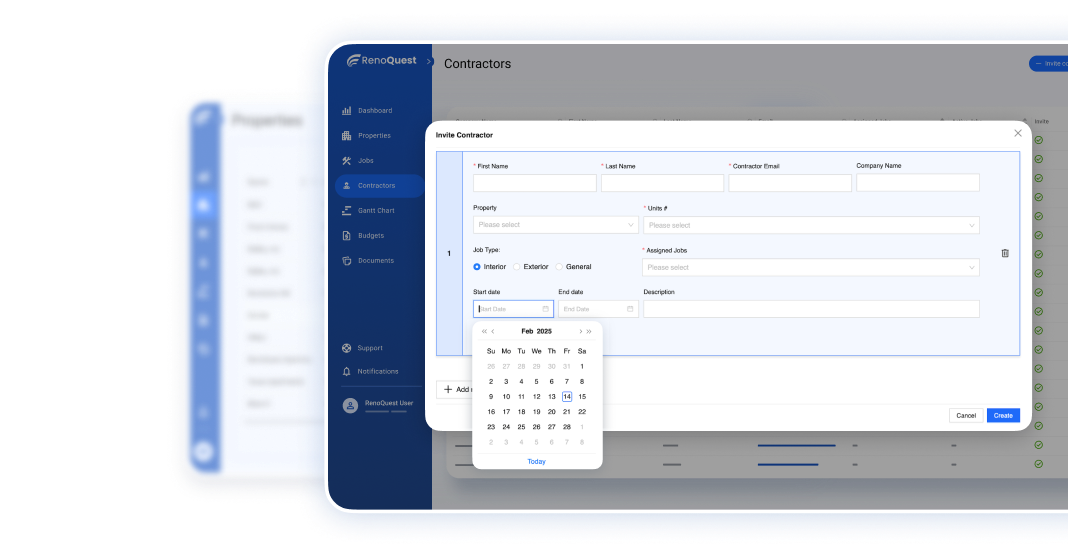
Assign tasks, schedule jobs, and receive updates from contractors all in one place. RenoQuest cuts down on miscommunication, delays, and email back-and-forth by keeping everyone synced.
Real-Time Budget Tracking
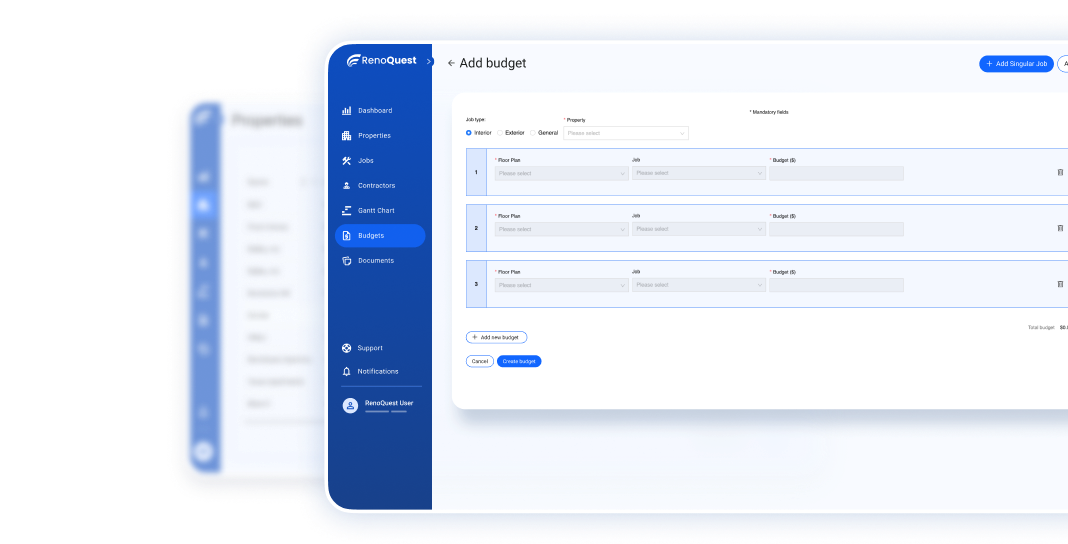
With 75% of renos going over budget, RenoQuest offers live cost monitoring to flag issues early. Its standardized pricing and scope tools help avoid costly surprises, users have seen up to 40% fewer budget overruns.
Faster Turnarounds
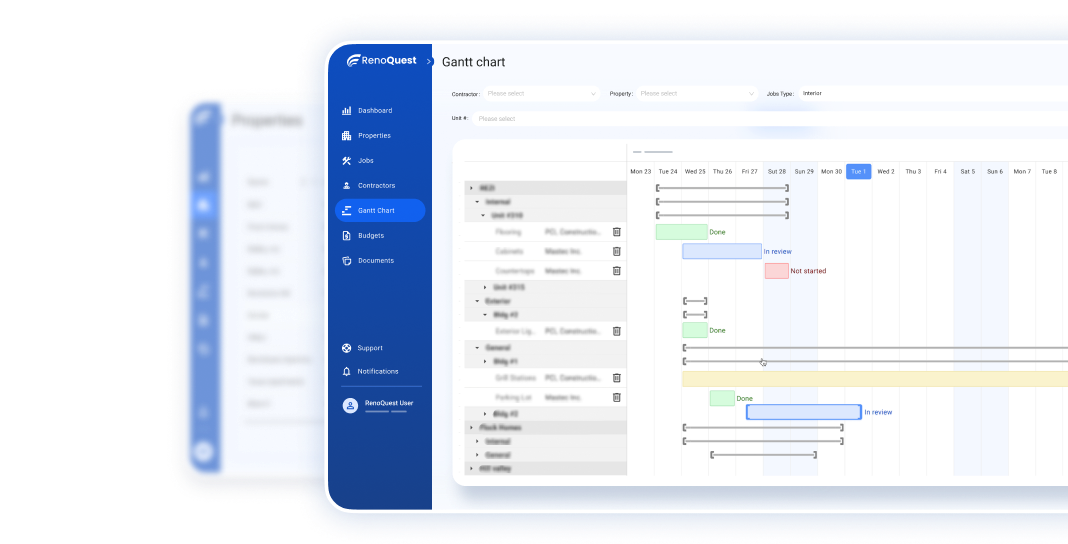
RenoQuest shortens project timelines by nearly 30%, helping managers get renovated units back on the market faster. That also means quicker lease-ups and reduced vacancy losses across portfolios.
Data-Backed Decisions
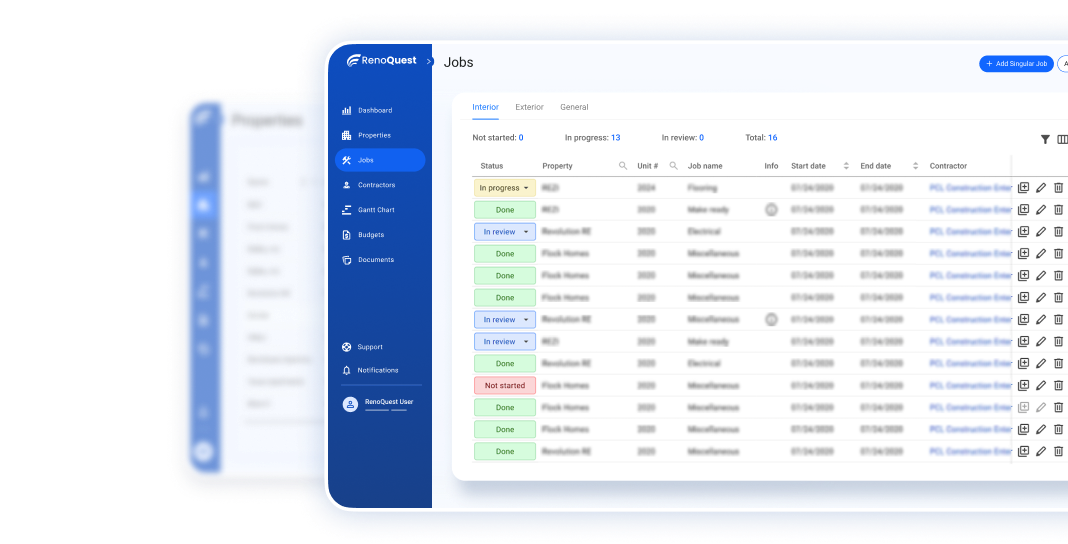
Track ROI on upgrades and discover which renovations actually drive rent increases. RenoQuest helps owners allocate renovation dollars more strategically, maximizing impact over time.
Team-Friendly

From managers to accountants, everyone stays on the same page. RenoQuest reduces admin work, offers full project visibility, and simplifies reporting, so decisions are based on facts, not guesswork.
The RenoQuest Advantage in Action
To wrap up, imagine you’re managing a 100-unit apartment complex built in the 1980s that’s starting to show its age. The owner decides it’s time for a major renovation: new kitchens and bathrooms in every unit, plus a facelift to the hallways and lobby.
With RenoQuest, you create a project plan for all 100 units, perhaps scheduling 5 units to be renovated per month in rotation. The system helps you coordinate each phase – from ordering materials to scheduling the electrician – and you can monitor progress daily. If a contractor is running behind, you see it immediately and can adjust other tasks.
The budget dashboard shows you that, say, Unit 101’s renovation is creeping 5% over budget because of a change order, so you decide to value-engineer Unit 102’s plan slightly to make up the difference.
The result? The entire 100-unit renovation finishes ahead of the original schedule and within the overall budget. Tenant disruptions were minimized and well-communicated, so you had fewer complaints. Upgraded units are renting for premium prices, and the owner is thrilled with the higher income and property value.
That’s the power of combining good property management practices with the right technology. Try it yourself and feel the difference!


